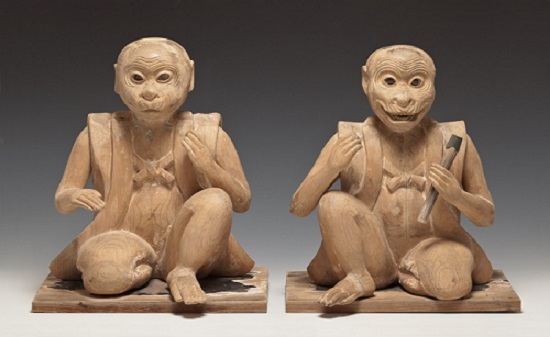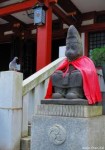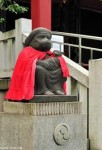


Unknown
Japanese
Pair of Monkeys, 1336-1573 Muromachi period
wood with traces of pigment and painted crystal eyes
16 3/4 x 14 7/8 x 10 1/2 in. (left), 17 x 15 x 11 3/4 in. (right)
SBMA, Gift of Klaus Naumann
2010.56.2.1-2
"Even monkeys fall from trees." - Japanese proverb
RESEARCH PAPER
Temple Origins
Monkeys are a common motif in Japanese Buddhist and Shinto art and lore, and this pair was likely crafted to grace the entranceway of a local temple in Japan. Early Shinto beliefs were grounded in religious awe and a respect for the natural world. Forms and styles of Buddhist art originated in India, then traveled through Korea and China to Japan, where artists developed and enhanced techniques, creating one of the world’s great traditions in religious sculpture.
These carved wood monkeys, possibly Japanese cedar, are from the Muromachi period (1336-1573), also called the Ashikaga Era after the first Muromachi shogun, Ashikaga Takauji. They represent an interesting sculptural transition between the Kamakura and Edo periods. The earlier, wildly inventive Kamakura period (1185-1333), featured a vigorous, often exaggerated realism perhaps best shown in the famous Ni-O guardians of Todai-ji Temple in Nara, Japan. (See also, SBMA’s unknown-heads-of-ni-o-buddhist-gate-guardians.) The later Edo period (1615-1868), saw a departure from religious and philosophical concepts to more organic, often humorous and irreverent expression prompted by increased interest in the literary and visual arts such as Noh and Kabuki theater. These monkeys are a charming blend of the two.
For comparative figures, see the accompanying images from Hie Shrine, Tokyo, Japan. These are monkey guardians, one a male, the other female, in the respective roles of monkey messenger and patron of fertility and safe childbirth.
Visual Analysis
SBMA’s pair of monkeys are not only lifelike, showing naturalistic detail with inlaid crystal eyes adding to a feeling of realism, but also a sly sense of drama and humor as seen in the human vest sported by each and the distress on the top of their heads suggesting that hats were originally present. Their facial expressions seem to mimic that of the stern Ni-O guardians. Their brows are furrowed. The mouth of one is open and of the other closed, in keeping with Ni-O tradition, where an open mouth indicates an “ah” sound and a closed one the “um” sound, together representing the first and last letters of the Sanskrit alphabet and the beginning and end of all things.
They present in a strong frontal position, directly facing the viewer, both with one knee tucked beneath, and arms raised purposefully. Traces of color remain, suggesting that the monkeys were once painted with polychrome, but this loss is our gain revealing a dramatic wood grain that the artist used to track the bend of the knees, the length of the abdomens, the downward sweep of the monkeys’ lapels. Customized flat or curved chisels, for which Japanese woodworkers are renowned, were used. Although both animals are seated, their line is vertical. Nevertheless, soft, rounded edges dominate from head to toe. The figure on the right holds a baton, but it is unclear if this represents a drum stick, banner, or weapon. The position of the figure on the left implies that it likely held something similar
Significance
Monkeys are considered sacred to the Shinto and Buddhist religions. They take on many roles, serving as demon quellers, kami (Shinto dieties), mediators and messengers between gods and humans, protectors against disease and patrons of fertility, safe childbirth, and harmonious marriages. The Japanese word for monkey is “saru” which also means “to leave,” thus hinting that the monkey could banish sickness or evil. People often place a figure of a monkey at the bedside of a sick child.
However, as the Japanese proverb above says, Even monkeys fall from trees, meaning nobody’s perfect. The monkey also represents less admirable traits and roles. As the most human-like of animals, he is an amalgam of the best and the worst, both beloved and vilified. He’s intelligent yet selfishly calculating, charming and humorous yet mischievous and vain.
What did the artist intend to convey here? An image of the monkey as hero or jester? Did these serve as actual temple guardians or were they an artist’s wry comment on earlier representations? From ancient times, monkey lore throughout Asia has been a complicated and curious mix of religion, culture, legend and folk belief. This pair offers a unique window into this world.
Prepared for the SBMA Docent Council by Geri Servi, April 11, 2013.
Bibliography
Addiss, Stephen (1996). How to Look at Japanese Art. Harry N. Abrams, Inc., Publishers, 1996.
Kato, Shuichi (1994). Japan Spirit and Form. Charles E. Tuttle Company, Inc., Rutland, Vermont & Tokyo, Japan.
Mason, Penelope (1993). History of Japanese Art. Harry N. Abrams, Inc., New York
Vecchia, Stefano (2007), Japanese Art. SCALA Group, S.p.A., Firenze.
Yoshikawa, Itsuiji (1966). Major Themes in Japanese Art. Weatherhill/Heibonsha, New York and Tokyo.
Japanese Buddhist Statuary (1995). www.onmarkproductions.com.
Heilbrunn Timeline of Art History, The Metropolitan Museum of Art, www. metmuseum.org.
SBMA CURATORIAL LABELS
These monkeys, wearing human clothes, were likely placed near the entrance to a shrine serving as guardians. Monkeys were regarded as sacred in both native Shinto religion and Buddhism and are considered mediators between deities and humans. Their open and closed-mouthed expressions are similar to that of the standing ferocious-looking Ni-Ō figures guarding Buddhist temple entrance. Together they suggest the chanting sound “ah-um” during meditation. “Ah” and “Um” are also the first and last letters of the Sanskrit alphabet, signifying the beginning and end of all things.
- Asian Art Reopening, 2021
